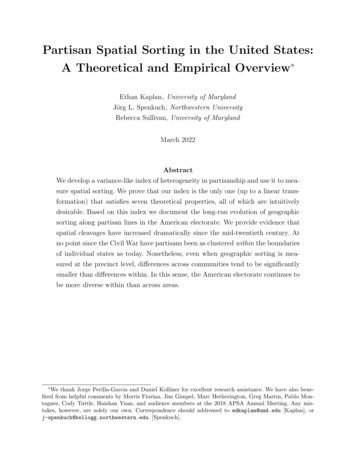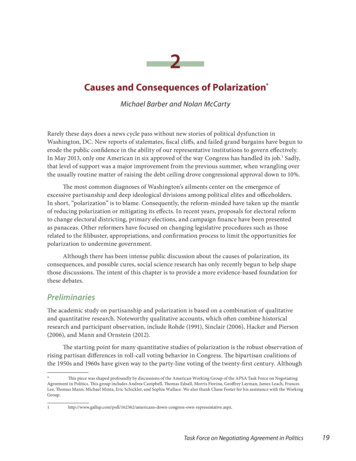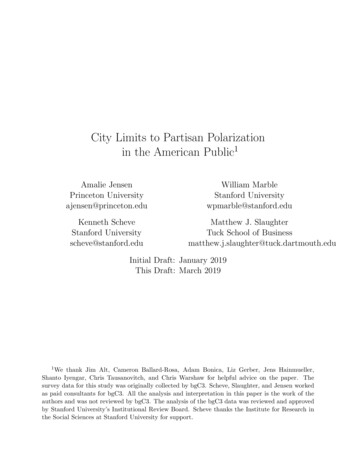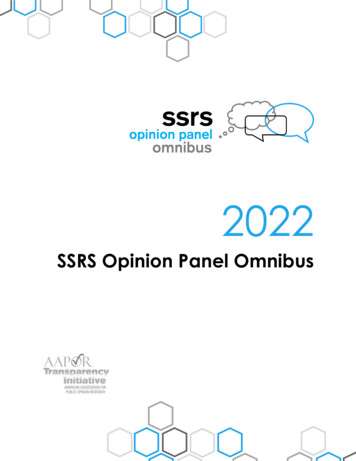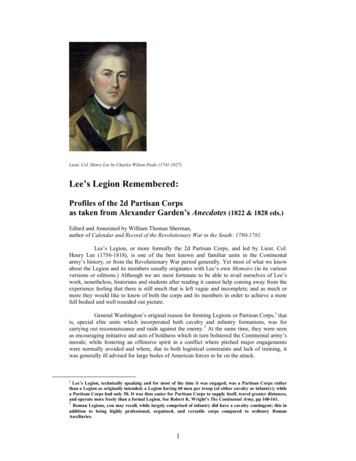
Transcription
The Worst PartisanGerrymanders in U.S.State LegislaturesChristian R. GroseAcademic Director, USC Schwarzenegger Instituteand Associate Professor of Political Science and Public Policy,University of Southern CaliforniaJordan Carr PetersonAssistant Professor, Texas Christian UniversityMatthew NelsonPh.D. Student, University of Southern CaliforniaSara SadhwaniUSC Schwarzenegger Institute Fellow
Executive Summary The worst U.S. state legislative partisan gerrymanders are the following: 1. Virginia; 2.Wisconsin; 3. Pennsylvania; 4. Michigan; 5. North Carolina; 6. Ohio; 7. Nevada; 8 (tie). Arkansas;8 (tie) Oklahoma; 9. Kentucky; 10. Tennessee. These states were classified as the worst U.S state legislative partisan gerrymanders based onanalyses of the statewide popular vote in 2017 or 2018 state legislative elections and the partisancomposition of the state legislative chambers in 2019. Criteria used to establish the worst gerrymandered states required that the state legislative lineswere drawn by a state legislature or by a partisan-leaning politician committee. The other criteriaassessed if the states had (1) minority rule in their state legislatures; (2) extremely disproportionaloutcomes where the popular vote was less than 59.9% total for one party yet the party in poweryielded more than 15 percentage points more in legislative seats following the 2018 elections; or (3)both minority rule and extremely disproportional popular vote-seat outcomes. 59 million Americans live under minority rule in their U.S. state legislatures following the 2018elections. Minority rule is defined as the party with the minority of votes in the most recent electionnevertheless controlling the majority of seats in the state legislature subsequent to that election. SixU.S. state legislatures were drawn by legislatures or partisan-leaning committees that resulted inminority rule following the 2018 elections. These states are Michigan, North Carolina, Ohio,Pennsylvania, Virginia, and Wisconsin. Many states have disproportional gaps between the percentage of the statewide popular votereceived in state legislative elections and the percentage of seats the party won. There are six stateswith extremely large differences of 15 percentage points or more between the statewide popularvote won and the percentage of seats won in the legislature. These states are Arkansas, Kentucky,Nevada, Oklahoma, Tennessee, and Wisconsin. 27 million Americans live in these states. Partisan redistricting is not limited to these states identified in the top 10 worst partisangerrymanders. These are simply the most egregious examples, circa 2019, drawn by legislatures orpartisan-leaning committees earlier in the decade. These data and analyses are new and have never been presented. Most work classifying partisanredistricting has examined congressional districts. Data for all U.S. state legislatures for thepercentage of statewide popular vote for each party and the percentage of seats for each party arepresented in this report’s appendix.
Which U.S. states have the worst state legislative partisan gerrymanders? Partisangerrymandering is defined as a political party in a legislature or partisan institution redrawinglegislative district lines in order to favor their own party in the subsequent election rounds. Weexamine all U.S. state legislatures that held elections in 2017 or 2018 to determine the top 10 worststate legislative gerrymanders in the country. This ranking of the worst gerrymanders is determinedby examining state legislatures with minority rule, which means the party with the majority of seatsin the legislature received a minority of the statewide vote in the previous election; and byexamining those states with extreme levels of disproportionality between the percentage oflegislative seats and the statewide vote in 2018.In most U.S. states, state legislators redraw their state legislative district lines. Typically, thisprocess occurs following the U.S. census every ten years. Self-interested legislators who seekreelection have long attempted to draw their own districts to protect their personal reelectionchances and to improve the electoral odds of their political party. 1 In 2011-12, when most statesengaged in redistricting, a number of legislatures or legislative committees were controlled by onepolitical party. This presented the opportunity for some of the most extreme partisangerrymanders that sought to protect the political parties that controlled the districting process.In 2019, the U.S. Supreme Court ruled that states – and not the federal courts – would bethe venue for remedies to partisan gerrymandering. Given this, we collect these original data on the2017 and 2018 state legislative elections and compare them to the seats in these state legislatures.These classifications and identifications of the worst partisan gerrymanders, as well as these neworiginal data on partisan composition of the statewide popular vote and legislative seat shares, arelikely to be of interest to scholars, lawyers, and practitioners.21
The worst states for legislative partisan gerrymanders after the 2018 electionsThe following states are the top 10 worst legislative partisan gerrymanders as of 2019. Toqualify for the list of worst partisan gerrymanders, the state legislative redistricting must have beendone by a legislature or partisan politician committee and had one or both of the following: (1) oneor both state legislative chambers had minority rule following the 2018 elections; and/or (2) thepercentage of the party’s seats was extremely disproportional to the statewide partisan popularvote.31. Virginia2. Wisconsin3. Pennsylvania4. Michigan5. North Carolina6. Ohio7. Nevada8 (tie). Arkansas8 (tie). Oklahoma9. Kentucky10. TennesseePartisan Gerrymandering and Minority RuleIn a surprisingly large number of U.S. states, minority rule occurs. Minority rule is definedas the party with the minority of votes in the most recent election nevertheless controlling themajority of seats in the state legislature subsequent to that election. In minority rule states, the statelegislative popular vote does not match the partisan control of the state legislative chamber.Minority rule in state legislative lower chambers. Following the 2018 elections, five statehouses with districts drawn by legislators or partisan-leaning committees reveal some of the mostegregious gerrymanders in the United States because they allowed governance via minority rule:Michigan, North Carolina, Pennsylvania, Virginia, and Wisconsin (see table 1).4 In four of thesestate houses elected in 2018, a minority of voters chose the party that nevertheless won themajority of the legislative seats. A fifth state, Virginia holds their state legislative elections in odd2
numbered years, and elected its state house in 2017. Virginia also had a political party control itsstate house that was chosen by a minority of voters.The governing party of these partisan gerrymandered legislatures has significant controlover legislative rules and public policy outcomes, yet received less than 50% of the vote from thosecitizens who chose to turn out in 2018. In all five of these states, Democratic candidates for statehouse received a majority of the statewide popular vote.5 Because of the way that the district lineswere drawn in these states, the Republican party won more seats than Democrats. There were nostate houses where the Republican party received a majority of the vote in 2018, but where theDemocratic party won a majority of the legislative seats.Table 1: Minority Rule in U.S. State Legislative Lower North CarolinaStatewide popular vote forgoverning party in 2018 (%)44.5%*44.7%45.6%47.4%48.2%Party’s seats in the state houseafter 2018 (%)51.0%64.6%54.2%52.7%54.2%*Virginia holds odd-year state legislative elections, and the election results in the second column are from 2017.As shown in Table 1, the differences between the vote of the majority and the legislativeseat outcomes are striking. Of all states in the country, Virginia is the state with the lowest popularvote share for the party (44.5%) that won a majority of the seats (51%). Just after Virginia isWisconsin, which had one of the most extreme partisan gerrymanders for its state house. InWisconsin, only 44.7% of the state’s voters chose a Republican in 2018 state house elections, yetthe Republican party won a whopping 64.6% of the state house seats. 6 Both the Virginia andWisconsin plans were drawn earlier by Republican-controlled state legislatures.7 A federal court inJanuary 2019 put in place a new map for the 2019 Virginia state legislative elections.83
Similarly, in Pennsylvania, 45.6% of the state’s voters chose a Republican candidate in2018, yet 54.2% of the legislative seats in the state house were held by Republicans following the2018 election. This map was drawn by a legislative committee composed of three Republicans andtwo Democrats. 9Two other states’ legislative-drawn maps resulted in minority rule with legislatorscontrolling the state house even when a majority of voters chose the other party in the 2018elections. In Michigan, 47.4% of its states’ voters picked Republican state house candidates in2018, yet 52.7% of the state house seats remained in Republican control following the election. InNorth Carolina, only 48.2% of the voters chose the governing party, though this party ended upwith 54.2% of the legislative seats, enough to control the outcome.The Michigan state legislative maps were drawn by the Republican-controlled Michiganstate legislature.10 In Michigan, in 2018, voters approved a ballot proposition, backed by a numberof redistricting reform advocates such as Governor Arnold Schwarzenegger (R-CA) and “VotersNot Politicians” spokesperson Katie Fahey, that would redraw legislative lines via independentcommission. Thus, the Michigan legislature will no longer be able to redraw its own district linesfor the 2022 cycle. North Carolina’s legislative districts, whether drawn by Democratic legislatorsor Republican legislators, have regularly been subject to litigation.11 In the most recent 2012redistricting cycle, North Carolina’s legislative lines were drawn by a Republican-controlled statelegislature.12 North Carolina’s state legislative districts remain in litigation as of 2019 in the caseCommon Cause v Lewis.Minority rule in state legislative upper chambers. We also examined the upper chambersof each state legislature for the possibility of minority rule following the 2018 elections. While notall state upper chambers were up for election in 2018, 42 states held elections for their statesenates. In addition, most state senates have staggered terms with approximately half of their state4
senate membership being elected in 2018 and the other half being elected in the previous electionperiod. In those cases where the entire state senate was elected in 2018, we compared the overallpopular vote for the state senate by party in the entire state to the percentage of seats in the entirestate senate. In those cases where only part of the state senate was elected in 2018, due tostaggered terms, we compared the overall popular vote in all the state senate districts up forelection to the percentage of seats won by each party in just those districts up for election in 2018.Four states have redistricting maps drawn by legislatures or partisan-leaning committeesthat produced minority rule in their state senate elections in 2018: Michigan, North Carolina,Ohio, and Pennsylvania. In the case of the Ohio state senate, 17 of its 33 state senate districts wereon the ballot. Across the state in these 17 districts, 47.2% of the voters chose the party that won58.8% of the seats. When the state senate redistricting occurred prior to 2012, a committeecomposed of four Republicans and one Democrat drew the state legislative lines.13 Ohio recentlychanged the rules of its state legislative redistricting, which includes a provision that the “statewideproportion of districts [with a party] must correspond closely to the statewide preferences of thevoters of Ohio.”14 These new rules will be in effect for the 2022 redistricting cycle. But based onthe map used for the 2018 elections, Ohio has one of the worst state legislative partisangerrymanders in the country given the presence of minority rule.Table 2: Minority Rule in U.S. State Legislative Upper ChambersStatePennsylvaniaOhioMichiganNorth CarolinaStatewide popular vote forgoverning party in 2018 (%)45.5%47.2%47.8%49.0%5Party’s seats won in the statesenate after 2018 (%)52.0%58.8%57.9%58.0%
In North Carolina and Michigan, the state senate elections revealed minority rule. Asshown in Table 2, a minority of these states’ voters chose Republican candidates for the statesenate in 2018, but Republican state senate candidates won over 50 percent of the elections. InPennsylvania, similarly, 45.5% of the vote went to the party that won 52.0% of the seats.Three of these states have minority rule for both their state houses and their state senatesbased on the 2018 elections: Michigan, North Carolina, and Pennsylvania. Republican-heldlegislatures in previous sessions drew the maps in Michigan and North Carolina; and a Republicanmajority legislative committee that included party leaders drew the Pennsylvania map used in 2018.These legislators had incentives to redraw the lines to protect their own electoral interests and theirparty’s electoral interests.Partisan Gerrymandering and What Minority Rule Means for AmericansWhen we consider minority rule in state house and state senate plans together, 6 stateshave minority rule in one or both of their legislative chambers thanks to partisan calculations madeby legislative mapmakers: Michigan, North Carolina, Ohio, Pennsylvania, Virginia, and Wisconsin.The total population of these states is 59.2 million people.15 This means that nearly 60 millionAmericans live under minority rule in their U.S. state legislatures following the 2018 elections.These legislators make public policies. The party that controls the most seats in statelegislatures is critical for determining outcomes.16 When a party controls one or both chambers,policy outcomes are much more likely to be in line with the party’s preferences and move in theideological direction favored by the majority party. 17 In these instances of minority rule, partisangerrymandering allows for legislatures to make decisions that may not reflect the public opinionand partisan leanings of their states as a whole.6
Gerrymanders in States with Disproportional Outcomes between Seats and VotesNot all partisan gerrymanders involve minority rule. In several states, partisan legislators orother partisan agents enacted plans that allow for many more legislative seats for the party thanreflected in the statewide popular vote. The relationship between statewide vote proportions andlegislative seat proportions has been studied extensively.18 While the relationship between votesand seats is not linear, we should not expect massively disproportional statistical relationshipsbetween seats and votes in states in which partisan competition is high. When a party wins justover 50% of the statewide vote, scholarship suggests that the party will often win a similar or slightlyhigher proportion of legislative seats in a redistricting plan.19 Given this, a simple measure of anextreme partisan gerrymander would be competitive statewide elections (where no party gets morethan 59.9% of the statewide vote), yet where the winning party receives a dramatically higherproportion of the seats in the state legislative chamber.To determine the worst partisan gerrymanders based on disproportionality betweenstatewide partisan votes and legislative partisan seat shares, we identify the following: (1) a state inwhich the majority party received 59.9% of the vote or less, thus suggesting the state has somemodicum of partisan competition; (2) a state in which the majority legislative party received 15percentage points or more seats relative to the statewide popular vote for the party; and (3) alegislature or a partisan-leaning politician committee conducted the redistricting earlier in thedecade.20The states that meet these criteria for extreme disproportionality in their state legislativegerrymanders based on the 2018 elections in either the state house or state senate are as follows:Arkansas, Kentucky, Nevada, Oklahoma, Tennessee, and Wisconsin. In all of these states, thestatewide partisan competition was fairly high, yet the winning party received at least 15 percentagepoints more seats than the popular vote for the same party.7
Table 3: Worst state house legislative gerrymanders, disproportional seats relative to votesNevadaWisconsinArkansasOklahomaStatewide popularvote for governingparty in 2018 (%)51.3%44.7%58.5%58.9%Party’s seats in thestate house after 2018(%)69.0%64.6%76.0%76.2%%-point differencebetween party’s statehouse seats and statehouse popular vote 17.7 D 19.9 R 17.5 R 17.3 RIn the state house elections in 2018, as shown in Table 3, Nevada had disproportionatepartisan outcomes. The Democrats received 51.3% of the statewide vote, but won 69.0% of thelegislative seats. This is a 17.7 Democratic gerrymander. In the Wisconsin state house, alreadyhighlighted earlier as a minority rule state, the Republicans received 19.9 percentage points morelegislative seats than they did votes. In Nevada, when these districts were drawn by the statelegislature earlier in the decade, the Democratic party controlled the legislature. In Wisconsin, theRepublican party controlled the legislature when these district lines were drawn.Two other states shown in Table 3 are Arkansas and Oklahoma. Arkansas has one of themost extreme partisan gerrymanders, as 58.5% of its voters chose Republican candidates for thestate house, but Republicans won 76.0% of the seats. This is a 17.5 point Republicandisproportionality difference. The Arkansas map was drawn by a three-member politiciancommission prior to the 2012 cycle.21 Similar to Arkansas, Oklahoma has an extremelydisproportionate partisan gerrymander. Republicans won 58.9 percent of the statewide popularvote, yet received 76.2% of the legislative seats in the Oklahoma state house ( 17.3 pointdifference). The Oklahoma map was drawn by a Republican-controlled state legislature.22Table 4 shows the state senate maps drawn by legislatures in partisan-competitive states,defined as the majority party receiving less than 59.9% of the popular vote, where the party8
received 15 percentage points more of the seats than statewide votes. Two states fit these criteriafor extreme partisan gerrymanders in state senates: Kentucky and Tennessee. In Kentucky, only57.9% of its state’s voters chose the Republican candidates for state senate in 2018, butRepublicans won 89.5% of the state senate seats up for election in 2018. This is a very large gap of 31.6 percentage points in favor of the majority party. In Tennessee, 58.9% of the voters chosethe Republican state senate candidates in 2018, but the same party won 77.8% of the senate seatselected in 2018 (a 18.9 Republican difference advantage between votes and seats won). Statelegislators themselves are responsible for redistricting state legislative lines in both Kentucky andTennessee.23 Tennessee’s map was drawn by a legislature controlled by the Republican party,allowing for the opportunity for a partisan gerrymander.Table 4: Worst state senate legislative gerrymanders, disproportional seats relative to votesKentuckyTennesseeStatewide popularvote for governingparty in 2018 (%)57.9%58.9%Party’s seats in thestate senate after 2018(%)89.5%77.8%%-point differencebetween party’s statesenate seats and statehouse popular vote 31.6 R 18.9 RThe impact of extreme disproportionality in these six states (Arkansas, Kentucky, Nevada,Oklahoma, Tennessee, and Wisconsin) is meaningful. About 27 million Americans live in thesesix states with extreme partisan gerrymandering as measured by very large disproportionalitybetween the state popular vote for parties and the seats won by the majority party.What Policy Actions Can Be Taken?This policy report has identified the worst U.S. state legislative gerrymanders in the 2018elections. In June 2019, in Rucho v. Common Cause and Lamone v. Benisek, the U.S. SupremeCourt ruled that litigation over partisan gerrymandering by the courts was to be left to the states.9
Particularly in the case of state legislative redistricting, the action will now be in the states.There are a number of avenues lawyers and practitioners are pursuing regarding the reduction ofpartisan gerrymandering at the state level. The first of these is via state initiatives and referenda. In2018, four states passed ballot propositions in the November elections (Colorado, Michigan,Missouri, and Utah) establishing redistricting commissions and creating nonpartisan standards ofevaluation of redistricting plans.24 These follow states like California, which passed its independentredistricting commission via ballot proposition and with the support of Governor ArnoldSchwarzenegger in 2008 for state legislative districts and in 2010 for congressional districts.25 Otherstates with ballot proposition opportunities are likely to pursue the citizen-initiative route by passingnew policies similar to these earlier state reforms.In other states, there are not ballot propositions for citizens at the state level. In thesestates, legislators themselves would have to vote to establish independent redistricting commissionsor other reforms that would require more nonpartisan criteria in the creation of district lines. Aslegislators are self-interested reelection seekers, reformers will face more of an uphill battlepersuading legislators to change the rules that benefit their personal reelections or their ownparties. In New Hampshire, legislators in both parties have recently voted to create a commissionin that state. 26 More research is needed to understand why and when legislators may be willing, if atall, to cede their authority to a commission or put additional restrictions on their mapmaking.Political reformers interested in curbing partisan redistricting may also want to think of newand creative legal ideas that may be more palatable to legislators. While it is difficult to persuadelegislators to change the laws to remove their direct influence over the redistricting process, a newpolicy idea would be to propose that minority rule following state legislative redistricting wouldtrigger a new redistricting cycle. While such a law would not address disproportional majority10
gerrymandering, such proposed legislation would set a minimum bar that legislatures do not drawmaps that will yield a majority of seats being elected from a minority of voters.While the federal courts have stepped away from the “political thicket” in Rucho andLamone, litigation at the state level is ongoing against many districts and is likely to continue.27Many state laws in those states where a partisan-leaning legislature or a partisan-leaning politiciancommission is charged with redistricting still have other restrictions. Litigation within these statesagainst the most extreme partisan gerrymanders may occur if violations of compactness,unnecessary splitting of municipal boundaries and communities of interest, and other restrictionsare needlessly violated.28 Legal opponents of partisan gerrymandering are likely to pursue thesestrategies in the future, taking a state-by-state approach to litigation against partisan gerrymanderswith a focus on violations of legal restrictions written in state law.The classification of the worst gerrymanders in the United States identifies those statelegislative maps that have minority rule or have extreme disproportionality. These data are newand have never been presented previously. Most work classifying partisan redistricting hasexamined congressional districts, and those that have examined state legislative redistricting havefocused on previous time periods. We present these data as a resource for scholars, lawyers, andpractitioners who may find them impactful or useful.11
Appendix I: The Statewide Popular Vote and Seats Won in the 2018 State House Elections% votes received statewide%-point differenceby Democratic party in% seats won bybetween party’s state2017 or 2018 state houseDemocratic party afterhouse seats and stateStateelections2018 state house elections house popular voteAlabama36.2%26.7%-9.5Alaska40.6%47.5% ifornia66.8%76.3% 9.5Colorado54.8%63.1% 8.3Connecticut52.9%60.9% 8.0Delaware59.1%63.4% i60.3%90.2% 29.9Idaho29.6%20.0%-9.6Illinois59.6%62.7% 0.0%32.0%-8.0Kentucky45.8%39.0%-6.8Maine52.7%58.9% 6.2Maryland66.3%69.5% 3.2Massachusetts73.9%79.4% 5.5Michigan52.1%47.3%-4.8Minnesota54.4%56.0% ada51.3%69.0% 17.7New Hampshire53.0%58.5% 5.5New Jersey58.1%67.5% 9.4New Mexico57.9%65.7% 7.8New York61.9%71.3% 9.4North Carolina50.5%45.8%-4.7North 2%23.8%-16.4Oregon57.2%63.3% 6.1Pennsylvania53.8%45.8%-8.0Rhode Island71.6%88.0% 16.4South Carolina39.0%35.5%-3.5South Wisconsin53.0%35.4%-17.6West Virginia47.8%41.0%-6.8Wyoming20.5%15.0%-5.5Note: If state is not displayed, there were no 2018 state senate elections or it is Nebraska (no parties in legislature).12
Appendix II: The Statewide Popular Vote and Seats Won in the 2018 State Senate Elections% votes received statewide%-point differenceby Democratic party in% seats won bybetween party’s state2017 or 2018 state senateDemocratic party afterhouse seats and stateStateelections2018 state senate elections senate popular 4.9%70.0% 5.1Colorado50.3%52.9% 2.6Connecticut53.1%66.7% 13.6Delaware57.9%60.0% 61.5% y40.3%10.5%-29.8Maine55.9%60.0% 4.1Maryland64.5%68.1% 3.6Massachusetts76.3%85.0% ntana42.5%44.0% 1.5Nevada49.9%54.5% 4.6New Hampshire53.8%58.3% 4.5New Jersey59.1%65.0% 5.9New York55.6%63.5% 7.9North Carolina50.1%42.0%-8.1North .3%29.2%-10.1Oregon59.6%64.7% 5.1Pennsylvania53.8%48.0%-5.8Rhode Island70.4%86.8% 16.4South -0.4Washington64.5%68.0% 3.5Wisconsin46.9%35.3%-11.6West Virginia44.1%47.1% 3.0Wyoming24.7%13.3%-11.4Note: If state is not displayed, there were no 2018 state senate elections or it is Nebraska (no upper chamber).13
1Yoshinaka, Antoine and Chad Murphy. 2010. “The Paradox of Redistricting.” Political Research Quarterly62:435-47.2The data and analyses presented here were conducted by the authors. To construct our dataset and compute thestatewide partisan vote, the authors used the Carl Klarner dataset. To compute the percentage of seats won after2018, the authors used the NCSL partisan composition dataset for those legislative chambers where 100% of seatswere up for election in the 2017 or 2018 elections. To compute the percentage of seats won in many state senatechambers and one state house chamber (North Dakota), in which the full membership was not up for election, theauthors calculated the percentage of seats won by each political party in 2018 by consulting each state’s Secretary ofState web site, Elections Division web site, or other data sources.3The criteria for disproportionality are detailed later in this report, but also include only those states in which theparty with the most seats won in 2018 received less than 59.9% of the vote. States ranked at the top have the mostdisparate levels of minority rule in one or both chambers; and states ranked in the lower top 10 have the mostdisproportional popular-vote-to-seats-won differences. States with disproportional state house maps are rankedabove those states with disproportional state senate maps as the state house maps covered the entire electorate andall districts; while only some of the senate districts were up for election in 2018.4Iowa is not displayed in Table 1, though it also had a minority of its voters choose the Republican state housecandidates in 2018 (see appendix). It is not displayed because Iowa’s map is not drawn by legislators, and onlylegislative-drawn or partisan politician commission-drawn plans are considered for inclusion in the list of worstgerrymanders. Iowa’s redistricting process starts with nonpartisan Legislative Services Agency (LSA) staff whodraw up the district plans following specific criteria such as preserving county lines. The legislature then approvesor declines the map produced by these LSA staff. More research should be conducted on the decisions that wentinto the 2011 redistricting in Iowa at the LSA staff level as well as the legislator decision-making stage to determineways that such a disproportionate map may be avoided in future redistricting cycles. Iowa is also not displayed inTable 2, which examines state senates, as it was not drawn by a legislature or partisan-leaning committee. For moreon the Iowa redistricting process for state legislative and congressional districts, see Hagle, Timothy M. 2013.“Redistricting in Iowa 2011.” In William J. Miller and Jeremy D. Walling, eds., The Political Battle overCongressional Redistricting. Lanham:
legislative district lines in order to favor their own party in the subsequent election rounds. We examine all U.S. state legislatures that held elections in 2017 or 2018 to determine the top 10 worst state legislative gerrymanders in the country. This ranking of the worst gerrymanders is determined





